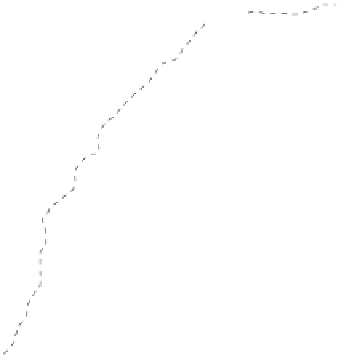Geoscience Reference
In-Depth Information
Bothner et al. 1981a,b). Consequently, in places,
trawling appears to be preventing shelf sedi-
ment accumulation, as well as increasing rates
of sediment transfer off the continental shelf.
Further attempts to quantify the sediment-
ary effects of trawling have been performed by
Palanques et al. (2001) on the unfished muddy
shelf of the north-west Mediterranean. The work
included study of the physical characteristics of
the bed sediments at 30 - 40 m depth, where there
is a natural nepheloid layer of SSC 2 -3 mg L
−1
,
which extends upwards from the bed for 3 - 8 m.
In calm conditions, use of an Otter trawl with a
4-m-wide line rope, towed along lines 2700 m
long, increased the SSC in the nepheloid layer to
5mgL
−1
. The impacts remain easily detectable
5 days after trawling, when the total weight of
suspended sediment in the area was 350 t, nearly
three times the original 120 t. Analysis of the silt
content of sediments in core samples indicated
that 2-3 cm of material had been eroded by the
trawl, and that 10% of this disturbed sediment
remained in the water column 4 -5 days after
trawling.
69
o
76
o
72
o
71
o
70
o
75
o
74
o
73
o
42
o
158
0
140
95
145
41
o
50
19
271
75
89
413
321
131
27
67 35 48
53
107
8
93
19
10
40
o
1
0
0
0
1
31
2
6
19
22
00
0
0
0
0
2 7
14
2
20
39
o
28
0
52
0
86 15
19
34
25
0
38
o
0
19
0
33
29
12
3
0
76
19
37
o
5
0
44
69
Area trawled/box area (%)
U.S. trawlers 1985
0
32
13
36
o
1
0
1
000
Fig. 10.10
Distribution of trawling by USA vessels over the
mid-Atlantic Bight. The number in each box is the relative area of
sea bed trawled (i.e. [cumulative trawled area/box area]
×
100).
Data are for 1985. (Adapted from Churchill 1989.)
10.3.2.3 Aggregate dredging
Trawling activity is intense on the mid-Atlantic
Bight. Churchill (1989) studied the sedimentary
impacts of trawling there, using regional data on
trawling activity, field observations and meas-
urements of the changes in suspended sediment
concentration (SSC) at 100 -120 m depth. Over-
all, trawling effort decreases with depth and dis-
tance across the shelf (Fig. 10.10), but trawling
is concentrated in some areas, such as the 'Mud
Patch', south of Cape Cod, where some areas are
trawled completely over three or four times per
year. Seasonal variations in natural resuspension
and in trawling activity mean that trawling is a
significant generator of suspended sediment on
the shelf, except during winter and early spring.
Once resuspended, material tends to move
downslope off the shelf, and Churchill (1989)
calculated that 70,000 t yr
−1
of sediment is lost
downslope from the 'Mud Patch', a loss equival-
ent to 0.2 mm yr
−1
. This is a significant rate com-
pared with the estimated rate of shelf sediment
accumulation of 0.2- 0.3 mm yr
−1
(calculated by
Extraction of marine aggregates from continental
shelves is largely based on the need to obtain
deposits of a particular range of grain sizes (sands
and gravels), primarily for building and construc-
tion purposes, but also for beach nourishment
and other minor uses. The volume of marine
aggregates extracted from the continental shelves
around Europe was 40
10
6
m
3
yr
−1
(for 1992-
97), with the UK and The Netherlands by far the
major extractors (Table 10.2). For the UK, an
average of 25
×
10
6
tyr
−1
of sand and gravel is
extracted from the shelf, representing about 20%
of all sands and gravels used in the UK. Licenced
extraction areas are concentrated on the southern
and eastern shelf, close to the economic activity
of southern England, although it is worth noting
that an area less than 12% of the total is actually
used each year (Table 10.3).
Typically, aggregate dredging is performed
by trailer suction hopper dredgers that operate
while underway, leading to the production of
×











